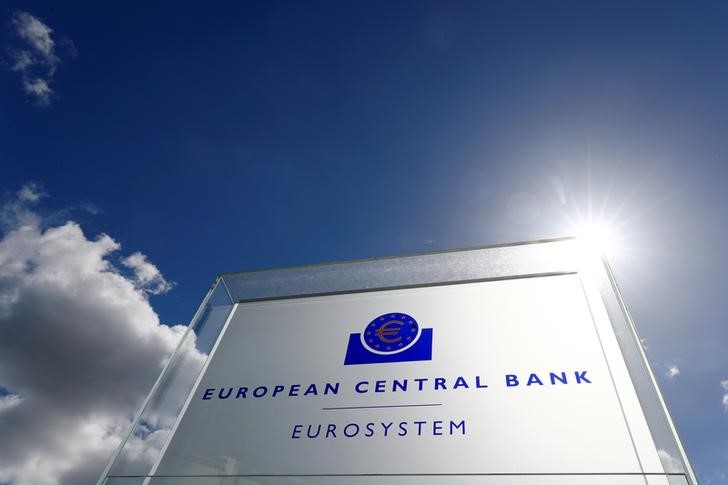By Dhara Ranasinghe, Ritvik Carvalho and Tommy Wilkes
LONDON (Reuters) - The European Central Bank meeting on Thursday is shaping up to be a lively one, given last week's comments from top officials.
A remark from chief economist Peter Praet that the ECB will debate whether to end asset purchases later this year has woken markets up to the possibility that a shift in policy is coming sooner than anticipated.
And it comes after a drubbing in Italy's bond market and softer economic data had raised some doubts over whether the ECB would, as expected, be able to start tapering its bond purchases this year. Here are some key questions in focus for markets.
1/ What will the ECB do on Thursday?
Judging by recent comments from central bankers, discussion about whether to end asset purchases this year will be on the agenda. Given that a shift in policy is now widely expected, whether that announcement comes this month or next is less important.
Note that Thursday's meeting is in Latvia, an external meeting outside Frankfurt that makes a major decision more difficult.
The ECB will also provide its latest forecasts for economic growth and inflation, which are likely to be scrutinized for clues on exiting quantitative easing (QE). The forecasts are likely to show faster inflation, but slower growth.
2/ If not June, when will the ECB's policy shift come?
For many economists, tweaks to the ECB's so-called forward guidance, which includes its outlook on asset purchases and interest rates, is more likely to come in July than June. It will then likely detail plans to wind up QE by year-end, while tempering market expectations for a rise in interest rates soon.
But some near-term caution is anticipated given a softening in economic data and uncertainty in Italy - the euro zone's third-biggest economy.
May's batch of closely-watched purchasing managers' index data pointed to a further slowdown of the bloc's growth momentum, while industrial orders from powerhouse economy Germany plunged in April.
Goldman Sachs (NYSE:GS) expects QE to be wound down by end-2018, with a rate rise likely in the second half of 2019. "We expect the forward guidance to be updated and link the rate path more directly to inflationary developments," the bank said in a note.
3/ Could the ECB still extend stimulus if it wanted to?
The short answer is no, or not really without redesigning the scheme -- something that is politically unviable when the economy is in decent shape and inflation is picking up.
The ECB faces a scarcity of eligible bonds it can buy for its unprecedented 2.55 trillion euro ($3 trillion) stimulus scheme, strengthening the case for a taper sooner rather than later.
Yet, the question of whether to extend bond purchases gained ground recently as some investors cast doubt on the ECB's QE exit strategy given a spike in Italy's borrowing costs.
Another way that has played out is in a scaling back of investor rate-hike bets -- although these have come back following the recent hawkish ECB comments. Money market pricing suggests investors price a rate hike by September next year.
4) How could Italy impact the ECB's exit plans for QE?
One way or another Italy is likely to come up, if not at the meeting, then at ECB chief Mario Draghi's news conference.
Some calm has returned to Italy's bond market with the risk of fresh elections averted for now, but with the new government bent on fiscal expansion and likely collision with the EU, uncertainty emanating from Rome is far from over.
That brings into question the ECB's role should the bond market buckle again. Latest data shows the ECB slowed its purchases of Italian government bonds in May, just as investors were offloading them. The bank has tried to counter accusations in Italy that it had deliberately bought less Italian debt to influence the formation of a new government.
Italy is one of the biggest beneficiaries of QE and tapering couldn't come at a worse time for a beaten-down bond market.
5) Will the ECB declare victory over inflation?
Stubbornly low euro zone inflation jumped by more than expected to 1.9 percent in May, lifting price growth to within the ECB's targeted range.
Policymakers say inflation needs to return to a level of below but close to 2 percent before it winds down QE and raises rates, so May's data raised expectations that an end to ultra-loose monetary policy is on its way.
The central bank is also likely to take comfort in a fall in the euro, which is down 1.3 percent on a trade-weighted basis <EUREER=ECBF> since the ECB's April meeting.
But core inflation - which is keenly watched by the bank and strips out volatile food and energy prices that were behind May's inflation jump - rose just 1.1 percent. The ECB says it looks past oil price shocks, even though they eventually feed through to headline inflation.

In short, the ECB will want to see target price growth persist for longer than a single month before the battle to increase inflation can be declared won.